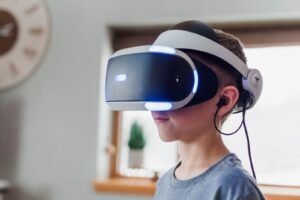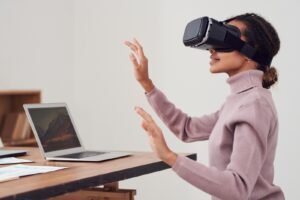Immersive learning in classroom
Seeking new immersive learning experiences for learning? Augment Explorer, is a leading educational VR company, which offers interactive and immersive learning experiences.
Welcome to the world of education of the future, where immersive learning is possible outside the walls of a typical classroom thanks to the technological advancement virtual reality (VR) and augmented reality (AR). With immersive and interactive experiences that improve comprehension and engagement, virtual reality (VR) and augmented reality (AR) are revolutionising how students are learn and are taught in the classroom.
The possibilities are boundless with VR technology, ranging from researching ancient civilisations to dissecting the human body or even travelling into space. Students can enter diverse worlds by donning a VR headset, taking on the roles of historical figures, or seeing abstract ideas come to life in front of their eyes.
In addition to sparking students’ interest and curiosity to seek new knowledge and facts, immersive learning experience also helps them learn difficult concepts better. For example virtual reality (VR) and augmented reality (AR) can stimulate a variety of senses, which improves learning retention and enjoyment.
VR and AR are already being embraced by educators as a potent tool for delivering educational content. VR has the potential to accommodate different learning styles, encourage critical thinking, and improve problem-solving abilities because of its capacity to design dynamic and interactive learning environments. We are seeing an immense change in teaching as VR technology develops further. Join Augment Explorer as we examine how VR is transforming the future of education and unleash its full potential.
Tips for effective immersive learning
Consider the following advice to promote excellent immersive learning experiences:
1. Start small: Before launching into more complicated projects, start with straightforward immersive learning experiences. Teachers and students will be able to become familiar with the technology and its possibilities as a result.
2. Encourage teamwork and collaboration: among students by doing this during immersive learning situations. This optimises the entire learning process and encourages peer-to-peer learning.
3. Offer direction and assistance: Provide explicit directions, checkpoints, or access to instructor support during the learning process to help students as they navigate through immersive learning activities.
4. Reflect and debrief: Take the time to reflect and discuss with students what you learned throughout an immersive learning experience. Talk about their findings, understandings, and any difficulties they faced. This contemplation strengthens learning and promotes metacognition.
5. Promote creativity: Give kids the chance to express it through engaging learning opportunities. This could entail making virtual art, building virtual architecture, or producing interactive stories.
6. Link practical experiences: Link immersive learning experiences to real-world scenarios and applications. Educate students on the practical applications of the knowledge and abilities they acquire through immersive learning.
You may increase student engagement and create a more beneficial and effective learning environment by incorporating these suggestions into your immersive learning experiences.
Future developments and trends for immersive learning
While immersive learning has many advantages, there are also some drawbacks and things to keep in mind. The expense of integrating VR and AR technologies in the classroom is one of the major obstacles. Because of the initial cost of the hardware and software, many educational institutions with tight budgets cannot afford it. There can also be continuing costs for upkeep and improvements.
The possibility for distraction is another thing to think about. With immersive learning opportunities, students could lose concentration on the learning goals because they are so absorbed in the virtual world. Striking a balance between involvement and maintaining the focus on the desired learning outcomes is vital for instructors. It’s crucial to figure out how to direct and encourage learning in an immersive environment.
Accessibility is also another issue to consider. Some students might not have access to the required technology outside of the classroom, which would prevent them from taking full advantage of immersive learning opportunities. Independent of their circumstances, educators must take into account other possibilities or offer equal opportunity for all students to participate in immersive learning.
Conclusion
VR and immersive learning have the power to change how students interact with and learn from instructional materials. VR can help students retain more information, accommodate various learning styles, and develop their critical thinking and problem-solving abilities by offering immersive and engaging experiences. The uses of virtual reality in education are numerous and diverse, ranging from interactive simulations to virtual field excursions.
Although there are issues and concerns to take into account, the advantages of VR in education outweigh the drawbacks. With VR technology’s continuing development and the expansion of VR platforms and tools, educators now have the chance to fully use VR and reimagine the future of education. Educational institutions can improve the learning environment for students of all ages by integrating virtual reality (VR).
On behalf of Augment Explorer, we hope you found this article about educational VR and immersive learning insightful. To read more article about VR education and augmented reality attractions please visit our blogs page.






